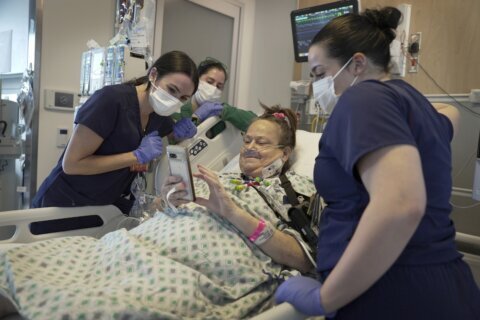THE BACKGROUND: 2021 was expected to be busy on the Mexican border. President Joe Biden, who took office in January, had said he was going to be a more welcoming president than his predecessor, President Donald Trump, and that alone was enough to encourage migrants to try to come to the United States.
But arrivals exceeded expectations soon after he took office. Children traveling alone shattered previous highs in March. The Border Patrol encountered migrants in South Texas more often than ever in June and July. And about 15,000 mostly Haitian refugees were camped under a bridge in a Texas border town in September.
The administration began a massive expulsion of Haitians while allowing thousands to remain in the U.S. Its uneven response after months of rising arrivals sparked sharp criticism from both the right and left, illustrating the consequences of scrapping Trump’s policies without a new asylum system in place.
Here, Associated Press journalists involved in the coverage reflect on the story and their own experiences.
___
ELLIOT SPAGAT: correspondent, San Diego.
So when I was in Rio Grande Valley and March, we were some of the few journalists who got inside a detention center where there were almost 4,000 unaccompanied children. There were 500 or 600 kids in some of these pods that were designed for 25 under COVID guidelines. They were packed in there like sardines. It was really something to see. A 17-year-old woman who had just just given birth was allowed in a separate area, but conditions were even worse than I saw under Trump. The chain-link fences of previous administrations, sometimes called “cages,” were replaced with plastic — thick plastic sheets. That was basically the same thing.
___
This was the third time since 2014 that very large numbers of migrants were coming across, many of them families and children from Central America but also increasingly from South America and Africa. Many of them get released, which encourages more to come. But then the ones who are maybe most in need can’t get across, for various reasons. I was haunted by this: there was a woman from El Salvador who had to flee her house in the middle of the night because a policeman was after her, wanted to kidnap her and take ownership of her, and she didn’t want him to know where her kids were. So she didn’t even say goodbye to them, and she fled. But she was kidnapped and raped and put into prostitution while in Mexico. She was assaulted in Tijuana and she couldn’t get across to claim asylum. There are people like her, and it’s just sad they can’t get in. Then, other people who probably are less deserving — in the sense that they’re coming just for work — they managed to get in.
___
GREG BULL, photographer, based in San Diego:
In May, for about a week or so, we had continuing coverage of folks arriving in droves. They’re crossing the border and asking for asylum. …. The vast majority were families coming in, so they would walk calmly to the closest (border) agent and turn themselves in. But what we were seeing more and more, and I’m sure you heard it from the others, was we were starting to see a bunch of kids coming in. And that was by far the most poignant and shocking thing to see: these 12-year-olds walking along through the mud in the middle of the night, in the rain, alone.
___
We met this girl Emely, and she’s 8, from Honduras. And she’s crying. She’s lost a shoe in the mud. She’s with this group, but she’s sort of an appendage to the group. And there’s some younger mothers in this group who were not nice to her, just kind of bickering with her. Like, “Come on, keep up. Where’s your shoe? How do you lose your shoe?” They’re less than sympathetic at this point, and she’s just crying. She meets up with the agent and it’s the middle of the night. … She’s got no documents, no info, she didn’t know where her mom was living in the States, or parents were living in the States. She wasn’t sure even where she came from at the last point in Mexico, but she’s from Honduras. And (border agents) had no way to link this kid to anyone on the U.S. side, or elsewhere.
So she was just basically to be put into the system, and then folks were going to have to try and figure some way to link her to somebody. We got info on her and I sent the picture in the middle of the night and it ended up running throughout the country on the Spanish news channels. Her mother was in Austin, Texas, saw it and was like, “That’s my daughter.” … And, long story short, they’re able to link up Emely back with her mom through this photo and also through (AP reporter) Adriana Gomez and (AP’s) Eugene Garcia’s video. So the three of us were able to link this family together. That’s the neatest thing that’s happened to me over the years. I was so excited.
___
JULIO CORTEZ, AP photographer based in Baltimore:
A little bit about my background: I came to the U.S. when I was 10 years old, and we were in a detention center for about a week. So I feel like I have a pretty good understanding of what people are going through. … Actually, my background opened up a great opportunity.
___
One of the stories that I’m most proud is that of Yancarlos, a 5-year old boy from Honduras. I’m on my way back home (to Baltimore) from the border … and I’m at the airport, just minding my own business eating a sandwich, waiting for my plane, and I overhear a conversation behind me. A man is asking this little boy in Spanish, “Are you excited about learning English? Are you excited about going to school in America?” And that lit a light bulb in my head so I dropped everything, I went over and talked to the kid’s mom and I said “Where are you coming from? Were you in one of those detention centers?” She’s like, Yeah. “And you got granted asylum?” Yeah. So all the things started lining up. So of course, now it’s my turn to say, “Well, I would like to photograph you.” I thought it was just going to be a quick portrait or something. And then I asked, “Where are you going, anyways?” And she’s like, “Oh, my brother’s waiting for us in Baltimore.” And I’m like, “Wait a minute. Are you on this next flight to Houston and then from Houston to Baltimore?” And she’s like, “Yep,” I said “Oh, please let me photograph you along the way. Let me tell your stories.”
The mother at first said “No, I don’t like cameras, I don’t know who you are. So I gave her my card and I said, “Look, this is a real company. That’s my name.” And she still wouldn’t. And I said, “The reason I want to tell your story is, we never hear what happens afterwards. And I can relate to you because” — and I laid out how it was for us, how we were in a detention center, how we were in a room with a just a mattress and no bedding, no pillows, nothing. We were there for a week and I said: “What your kid went through the last few days, I went through when I was a kid. And you know, nobody ever told my story, which is okay, but I want to tell his story.” And she said, “OK, you can photograph us.”
It was just such a cute story. The boy is 5 years old and in a little Superman outfit with a little hoodie, and he’s looking out the window and seeing his very first plane he’s going to ever be on, and he and his mom have never flown. … Mom’s terrified but the little boy, once they get in the in the air, he’s touching all the buttons, and she’s like, “No, no.” And I’m like, “No, I get it. I remember my first flight.” So that was a really cool story because I just followed them along the way and told a really sweet story of Yancarlos who didn’t get sent back to Honduras where things are really, really scary for him.
___
For a full overview of the events that shaped 2021, “A Year That Changed Us: 12 Months in 150 Photos,” a collection of AP photos and journalists’ recollections, is available now: https://www.ap.org/books/a-year-that-changed-us
Copyright © 2024 The Associated Press. All rights reserved. This material may not be published, broadcast, written or redistributed.







